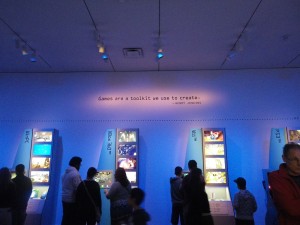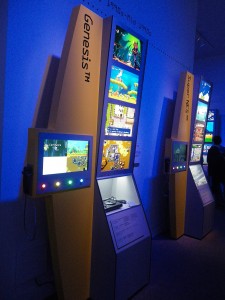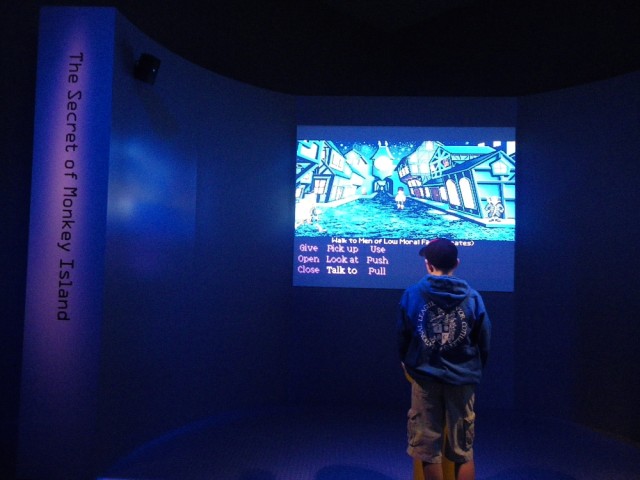The Smithsonian American Art Museum was full of a new kind of art this weekend: “The Art of Video Games,” their newest exhibit. While many joked about the absence of Roger Ebert, mostly there was an atmosphere of awe and reverence. It was a relief to see this much-contested medium celebrated instead of seeing it as the dispute of some controversial legislature. To many gamers present that weekend, the nostalgia felt a lot like our childhoods: it felt like home.
 The exhibit was developed by guest curator and longtime gamer Chris Melissinos, who worked hard for nearly three years on it. The exhibit begins with an introduction from Melissinos, who talks about his introduction to – and romance with – video games. A room to the side has dozens of televisions, showing games in different countries throughout history. Continuing into the exhibit is a montage of some of the industry’s greatest creations: from Marble Madness to Heavy Rain, Pitfall to Shadow of the Colossus. I let the images wash over me, remembering the countless hours I spent as a child on Marble Madness alone.
The exhibit was developed by guest curator and longtime gamer Chris Melissinos, who worked hard for nearly three years on it. The exhibit begins with an introduction from Melissinos, who talks about his introduction to – and romance with – video games. A room to the side has dozens of televisions, showing games in different countries throughout history. Continuing into the exhibit is a montage of some of the industry’s greatest creations: from Marble Madness to Heavy Rain, Pitfall to Shadow of the Colossus. I let the images wash over me, remembering the countless hours I spent as a child on Marble Madness alone.
Inspirational quotes cover the walls, and one that adorns the wall as you enter the next part of the exhibit is particularly poignant:
Three Voices: Artist, Game, Player
Video games combine graphics, sound, story, and interaction to create meaningful and immersive experiences. Imaginative artists and designers use this medium to create worlds and tell their stories. None of this is possible, however, without the participation of the player. Everyone who plays a game puts a little of themselves into the experience, and takes away something that is wholly unique. This conversation among the game, the artist, and the player is critical to understanding video games as art.
 On one wall, there are several screens, showing reactions of players to games. The opposite wall has five screens, with the title “Advances in Mechanics” over it, each screen showing a different era in gaming. The rest of the wall is covered in concept art, ranging from original ideas for Sonic the Hedgehog to Metal Gear Solid 4: Guns of the Patriots. Display cases have original games from decades ago, giving us a chance to see some of the games that were discussed on the Pioneers panel.
On one wall, there are several screens, showing reactions of players to games. The opposite wall has five screens, with the title “Advances in Mechanics” over it, each screen showing a different era in gaming. The rest of the wall is covered in concept art, ranging from original ideas for Sonic the Hedgehog to Metal Gear Solid 4: Guns of the Patriots. Display cases have original games from decades ago, giving us a chance to see some of the games that were discussed on the Pioneers panel.
But an exhibit about video games wouldn’t be the same without some hands-on experience. Available to play in the next room were Pac-Man, Super Mario Bros., Flower, Myst, and The Secret of Monkey Island. While it was interesting to watch younger generations playing some of the older games here, the best moment for me was out in the courtyard. Consoles were set up everywhere during GameFest (these won’t be available outside of this past weekend, unfortunately). A young boy, perhaps six or seven, sat down to play Super Mario Bros. 3 on the original NES. He held the controller vertically as though he was using a Wii Remote and tried to start playing. His father adjusted it in his hand, and those of us who had noticed laughed softly behind our hands – not to mock the boy, but because we realized we had reached that threshold. We all officially felt “old.”
Possibly the greatest part of the exhibit is the huge room filled with home consoles, each in a glass case with the name of those who had lent them to the museum. They were in order of year, separated into eras. Each console had a screen attached to it with buttons that read “Action,” “Target,” “Adventure,” and “Tactics,” and hitting the button showed you the game in question. Tactics games on display included Utopia on the Intellivision, Dune II: Battle for Arrakis for the Sega Genesis, and StarCraft for the PC, while the Adventure category held much-beloved games like The Legend of Zelda, Final Fantasy VII, Shenmue, and Mass Effect 2. A complete list of the games can be found at the Smithsonian American Art Museum’s website.
 Despite all the people, the exhibit felt peaceful and serene. I saw so much appreciation and happiness on so many smiling faces. There was no talk of violence in games or any of the issues that have plagued the industry for so long. But the lack of controversial topics doesn’t neuter the exhibit. If anything, it drives the point home: this exhibit is a celebration of video games as art. It’s not another place for politics to take roost; it’s not a place for fanboys and console wars, either. The purpose of it is to bring people together to appreciate the beauty , art, and history of home console video games.
Despite all the people, the exhibit felt peaceful and serene. I saw so much appreciation and happiness on so many smiling faces. There was no talk of violence in games or any of the issues that have plagued the industry for so long. But the lack of controversial topics doesn’t neuter the exhibit. If anything, it drives the point home: this exhibit is a celebration of video games as art. It’s not another place for politics to take roost; it’s not a place for fanboys and console wars, either. The purpose of it is to bring people together to appreciate the beauty , art, and history of home console video games.
A quote from thatgamecompany’s Jenova Chen stayed with me long after I left D.C.: “Games have so much freedom. You can go anywhere you want.” Whether you’re trekking the desert with a stranger in Journey, or saving Little Sisters in BioShock; if you’re holding Yorda’s hand in Ico, or using a Town Portal in Diablo II… whatever it is, one thing is clear: video games are far more than just escapism. The question of whether or not video games are art has become a moot point. The creativity of creators and players have joined together in a unity that transcends the question.
Go see the exhibit. It’s at the Smithsonian American Art Museum until September 30th, 2012, and will then be going on a ten-city tour. It’s worth seeing if you love video games. But you might want to stay the weekend.








